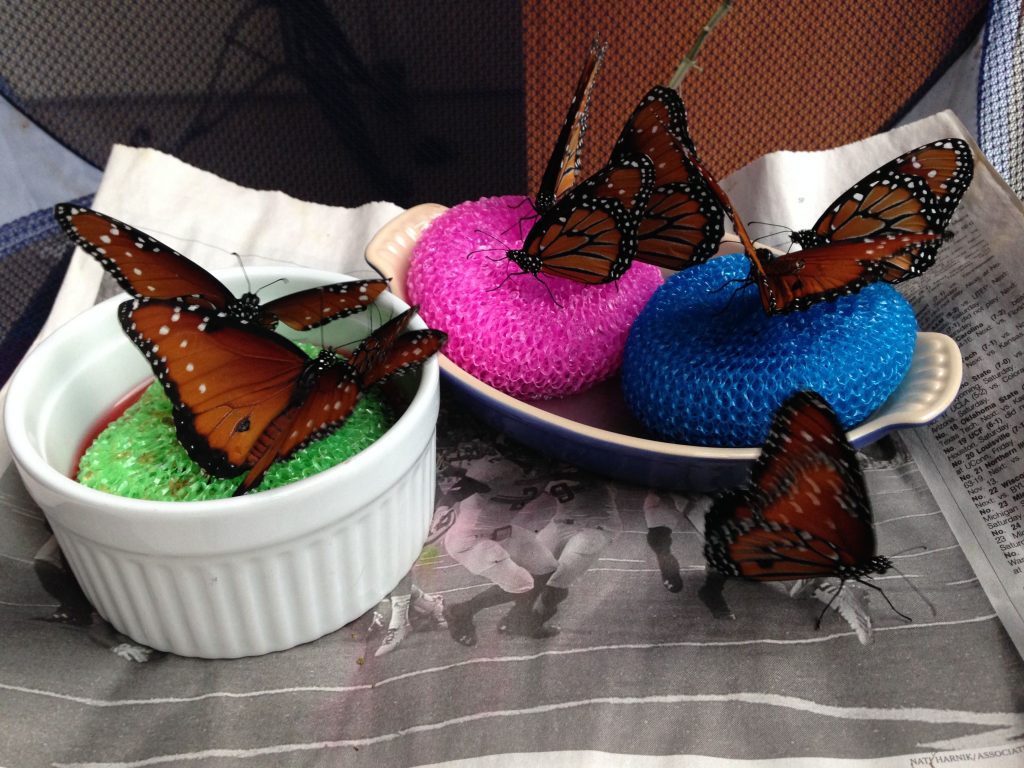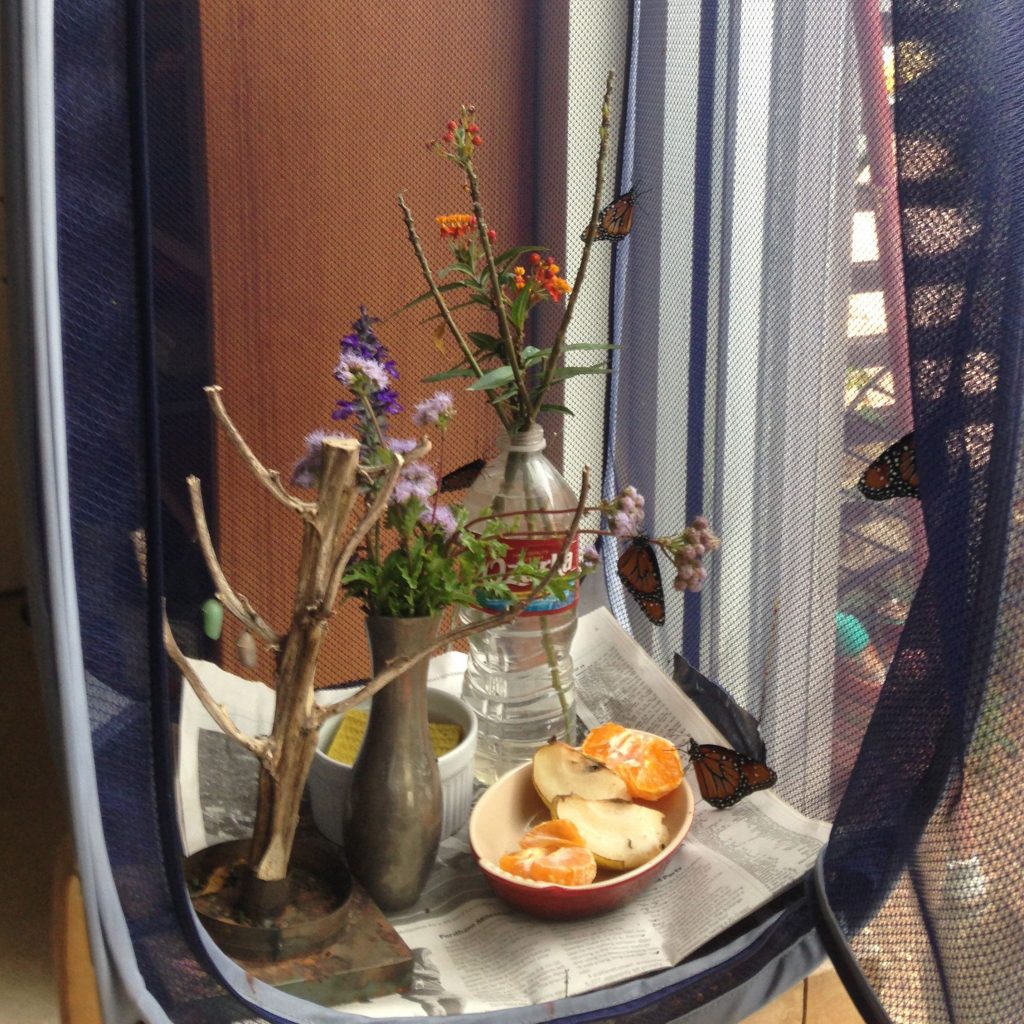The first week of 2017 can be likened to the worst of a bad relationship, vacillating between hot and cold so drastically we’re left perplexed. What to wear–sweater and long johns or shorts and a t-shirt?

San Antonio Mayor’s Mikey the Monarch hatched and was released at the San Antonio Zoo flighthouse on January 5. The temperature outside was in the 40s. Photo courtesy San Antonio Zoo
Imagine what that’s like for butterflies and other cold-blooded creatures.The first six days of San Antonio’s New Year had temperatures swinging from 29 to 81.
Such drama will continue. With cozy pockets of our urban heat islands creating perfect microclimates for year-round host plants, Monarchs, Queens Gulf fritillaries and others continue to lay their eggs irrespective of the seasons. The eggs will hatch, morph into 
Then what? It’s 29 degrees outside.
Generally, butterflies won’t fly when temperatures are less than 55 or 60 degrees. And after spending weeks fostering an egg, then a caterpillar, and finally a chrysalis to the point of becoming a butterfly, the idea of unleashing it into a cold, wintry wind seems brutally unacceptable.
“Cold weather does a number on all insects. That’s a given,” said entomologist MIke Quinn, who runs the über helpful insect education website Texasento.net.
I’ve stopped raising butterflies at home in the winter because the stress of having to deal with these late season beauties cancels much of the fun for me. After December 1, I let Nature do her thing.
But I get that many can’t resist having colorful creatures lilting around your home or office providing their unique charms in the dead of winter.
Our butterfly friendly Mayor Ivy Taylor hatched Mikey the Monarch on January 5. Mikey got a free ride to the San Antonio Zoo to live out the rest of his life in the climate controlled flighthouse filled with coddled milkweed and other plants the Zoo keeps in its greenhouse. Education manager Laurie Brown said Mikey may be released to the elements if temperatures warm up.
Our friend, District 1 City Councilman and Monarch Butterfly and Pollinator Festival docent Roberto Treviño got lucky with a milkweed plant we gave him in November. The gift included one fifth star Monarch caterpillar and one Monarch chrysalis. Yet Treviño ended up with four extra butterflies-in-progress. Unbeknownst to us, several eggs were hiding in the milkweed plant.
Councilman Treviño tagged and released the Monarchs, which hatched around Thanksgiving. He’s hatched several Queens since, the last of which emerged this week on a chilly winter day. His strategy? Hold the butterflies indoors until the weather warms up, then release them on the San Antonio River.

San Antonio City Councilman Roberto Treviño’s Thanksgiving Monarch. It was a boy. Photo courtesy Roberto Treviño

This Queen hatched in January in Treviño’s office. Check out the frass on the keyboard and around the computer. Photo courtesy Roberto Treviño

Caterpillar found its way to the computer plug to make its chrysalis. Hey, it’s warm back there! Photo courtesy Roberto Treviño

Is San Antonio a butterfly friendly city or what? Photo courtesy of Roberto Treviño
So for those who can’t resist fostering butterflies in winter, here’s some tips for dealing with late season butterflies, recast from a 2013 blogpost.
Entomologist Quinn suggests if you bring in found caterpillars, eggs or chrysalises, park them on a screened porch or cool garage to slow down their development in anticipation of warmer weather. Quinn points out that some butterflies overwinter in the chrysalis stage (like Swallowtails) while others, like Monarchs, overwinter in the adult, butterfly stage.
If you have adult butterflies and want to hold them for warmer days, Connie Hodson, a butterfly breeder and owner of Flutterby Gardens in Tampa Bay, Florida recommends sponges–scrubbers, actually–soaked in grape- or punch-flavored Gatorade laid out in shallow dishes in a butterfly cage.

Baby, it’s cold outside: soak scrubbers in Gatorade so butterflies can fuel up for when the weather turns. Photo by Monika Maeckle
Since butterflies taste with their feet, you have to set them on the sponge so they can “taste” the fake nectar, whetting their appetite. At that point, they’ll extend their long proboscis and slurp some fuel to power their flight.
You can try bringing in cut or potted flowers and laying out a spread of overripe fruit in the butterfly cage. Cotton balls soaked in sugar-water and apple juice are
another option. I’ve had mixed success with this. Sometimes the butterflies accept the smorgasbord, but mostly not.
Butterfly breeder Barbara Dorf of Big Tree Butterflies in Rockport likes to use tried-and-true hummingbird nectar–four parts water to one part sugar. She said a shallow dish or the top of a plastic container work well as a feeding station. Lightly misting the sides of the cage with water helps the butterflies stay hydrated. “All you can do is keep them til a good warm day,” said Dorf.
Hodson pointed out that recently hatched butterflies are not hungry for the first 24 – 48 hours, so if sun is in tomorrow’s forecast, just wait. If days pass and the weather hasn’t turned, continue offering fresh nectar surrogates and keep spritzing the netting of the cage.
If the butterflies resist the sponge or scrubber, Hodson suggested taking a Q-tip, dipping it in the Gatorade and gently touching the creatures’ proboscis so they get the hang of it.
More posts like this:
- Baby, it’s cold outside: what to do with late season butterflies
- How to Raise Monarch Butterflies at Home
- Part II: More Tips on Raising Monarch Caterpillars and Butterflies at Home
- Tropical Milkweed: To Plant it or Not is No Simple Question
- Oh Those Crazy Chrysalises: Caterpillars in Surprising Places
- Butterfly FAQ: Is it OK to Move a Chrysalis? Yes, and here’s how to do it
- Should You Bring in a Late Season Caterpillar into Your Home?
Like what you’re reading? Don’t miss a single post from the Texas Butterfly Ranch. Sign up for email delivery, like us on Facebook, or follow us on Twitter, @monikam.


Many of the people on my Monarch FB page have been having the same problem.
If you use sponges or cotton balls, make sure to clean them each day.
I’m like you…the stress of having eclosing butterflies is just more than I want to deal with. I’m having enough trouble keeping my milkweed plants from drowning.
I recently found a bottle of butterfly nectar feeder when flowers are still scarce.
feeder when flowers are still scarce.
at our local nursery. It works well to hold the chrysalis hatched in the guest room for a couple of days, then outdoors in a butterfly
Or, mail them to S Tx. At least two of us in Tx have USDA-APHIS permits to receive late season monarchs from other states E of the Rockies, for release here in Tx, to continue S or stay in S Tx. I’m in central Tx, another person is receiving them now in far S Tx. Within the Tx state borders, no permit is even necessary, just safe shipping practices.
I was permited in fall 2015, received mostly chrysalides, but some adults, in 2015 & 16 & a few cats, the other person started in fall of ’16 and is STILL busy!!!
This all came about based on my reading and hearing about the NY monarch that was flown by SW Airlines to SA for release at the botanical center a few years back, in Oct I think. It got my long time, was monarch raising wheels to turning, thinking….WHY can’t this be done for other late season monarchs, those stranded by cold weather and loss of nectar sources along the way to get them S.
…. NOW, it’s happening!
There IS that option now available to others!
Diane,
Please let us know where you are. I have a monarch that would love to be over-nighted to TX
I live in northern Michigan and several years ago I had a monarch inclose and our weather was getting real bad, there wasn’t anymore nectar flowers for this poor guy so I packed him/her carefully and overnighted him to my friend in Kansas. I have also taken several with me when I drove to Kansas. Michigan milkweed and Kansas milkweed look different, who knew?
Who in Texas can I mail my late hatching monarch to from MN?
Hi, I live in Virginia. My class has 11 butterflies and we don’t know how to release them since it’s very now 60 degrees to lows in the high 40’s at night. Could you advise me what to do?
Sheila Mccloskey
Sheila Mccloskey46@gmail.com
571-422-6371
This is a “Mommy and Me” class and they are so excited and not want to lose them
Thank you for any information.
Hi Sheila,
Please let me know if you get any responses. I also have a monarch that I would like to ship.
Cathie
Cw1gtwo@aol.com